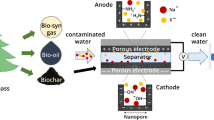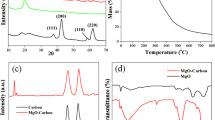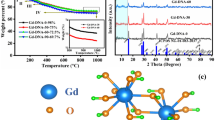Abstract
In this work, we synthesized metal-organic framework Cu3(BTC)2 which was applied as the doping materials of anode electrodes in capacitive deionization (CDI) for the first time. Cu3(BTC)2 possessed a hierarchical channel structure and a specific surface area as high as 2160 m2 g−1. Fifty weight percent of Cu3(BTC)2-doped activated carbon electrode (AC-M5) demonstrated better hydrophilicity, greater capacitance performance, and smaller material internal resistance than AC electrode. Capacitive deionization experimental result showed AC-M5 had the biggest electrosorption capacity of 35 mg g−1, which was 2.2 times higher than that of control. In addition to the excellent surface structure and electrochemical performance, the electrostatic force derived from Cu2+ greatly enhanced the adsorption performance of electrodes. The effect of desalination at the anode was much greater than that at the cathode, which also verified the effect of electrostatic forces on adsorption. Simple doping greatly improved the electrosorption capacity, indicating that Cu3(BTC)2 should be a promising doping material in anode for highly capacitive deionization applications.








Similar content being viewed by others
References
Shen J, Li Y, Wang C, Luo R, Li J, Sun X, Shen J, Han W, Wang L (2018) Hollow ZIFs-derived nanoporous carbon for efficient capacitive deionization. Electrochim Acta 273:34–42
Chen Z, Zhang H, Wu C, Luo L, Wang C, Huang S, Xu H (2018) A study of the effect of carbon characteristics on capacitive deionization (CDI) performance. Desalination 433:68–74
Andres GL, Mizugami T, Yoshihara Y (2017) Simulation of an electric behavior of the CDI system. Desalination 419:211–218
Cai W, Yan J, Hussin T, Liu J (2017) Nafion-AC-based asymmetric capacitive deionization. Electrochim Acta 225:407–415
Li Y, Liu Y, Shen J, Qi J, Li J, Sun X, Shen J, Han W, Wang L (2018) Design of nitrogen-doped cluster-like porous carbons with hierarchical hollow nanoarchitecture and their enhanced performance in capacitive deionization. Desalination 430:45–55
Chang L, Hu YH (2018) Highly conductive porous Na-embedded carbon nanowalls for high-performance capacitive deionization. J Phys Chem Solids 116:347–352
Sun Z, Chai L, Liu M, Shu Y, Li Q, Wang Y, Wang Q, Qiu D (2018) Capacitive deionization of chloride ions by activated carbon using a three-dimensional electrode reactor. Sep Purif Technol 191:424–432
Ratajczak P, Suss ME, Kaasik F, Béguin F (2019) Carbon electrodes for capacitive technologies. Energy Storage Mater 16:126–145
Li J, Ji B, Jiang R, Zhang P, Chen N, Zhang G, Qu L (2018) Hierarchical hole-enhanced 3D graphene assembly for highly efficient capacitive deionization. Carbon 129:95–103
Ma D, Wang Y, Han X, Xu S, Wang J (2017) Electrode configuration optimization of capacitive deionization cells based on zero charge potential of the electrodes. Sep Purif Technol 189:467–474
Leong ZY, Lu G, Yang HY (2019) Three-dimensional graphene oxide and polyvinyl alcohol composites as structured activated carbons for capacitive desalination. Desalination 451:172–181
Gao T, Li H, Zhou F, Gao M, Liang S, Luo M (2019) Mesoporous carbon derived from ZIF-8 for high efficient electrosorption. Desalination 451:133–138
Jo H, Kim KH, Jung M-J, Park JH, Lee Y-S (2017) Fluorination effect of activated carbons on performance of asymmetric capacitive deionization. Appl Surf Sci 409:117–123
Zhang L, Liu Y, Lu T, Pan L (2017) Cocoon derived nitrogen enriched activated carbon fiber networks for capacitive deionization. J Electroanal Chem 804:179–184
Li Y, Shen J, Li J, Sun X, Shen J, Han W, Wang L (2017) A protic salt-derived porous carbon for efficient capacitive deionization: balance between porous structure and chemical composition. Carbon 116:21–32
Li N, An J, Wang X, Wang H, Lu L, Ren ZJ (2017) Resin-enhanced rolling activated carbon electrode for efficient capacitive deionization. Desalination 419:20–28
Guyes EN, Shocron AN, Simanovski A, Biesheuvel PM, Suss ME (2017) A one-dimensional model for water desalination by flow-through electrode capacitive deionization. Desalination 415:8–13
Xie Z, Shang X, Yan J, Hussain T, Nie P, Liu J (2018) Biomass-derived porous carbon anode for high-performance capacitive deionization. Electrochim Acta 290:666–675
Yasin AS, Mohamed IMA, Amen MT, Barakat NAM, Park CH, Kim CS (2019) Incorporating zirconia nanoparticles into activated carbon as electrode material for capacitive deionization. J Alloys Compd 772:1079–1087
Wang M, Xu X, Liu Y, Li Y, Lu T, Pan L (2016) From metal-organic frameworks to porous carbons: a promising strategy to prepare high-performance electrode materials for capacitive deionization. Carbon 108:433–439
Liu Y, Xu X, Wang M, Lu T, Sun Z, Pan L (2015) Metal-organic framework-derived porous carbon polyhedra for highly efficient capacitive deionization. Chem Commun (Camb) 51(60):12020–12023
Xu X, Wang M, Liu Y, Lu T, Pan L (2016) Metal–organic framework-engaged formation of a hierarchical hybrid with carbon nanotube inserted porous carbon polyhedra for highly efficient capacitive deionization. J Mater Chem A 4:5467–5473
Yang R, Li K, Lv C, Cen B, Liang B (2019) The exceptional performance of polyhedral porous carbon embedded nitrogen-doped carbon networks as cathode catalyst in microbial fuel cells. J Power Sources 442:227229
Saraf M, Rajak R, Mobin SM (2016) A fascinating multitasking Cu-MOF/rGO hybrid for high performance supercapacitors and highly sensitive and selective electrochemical nitrite sensors. J Mater Chem A 4:16432–16445
Gascon J, Aguado S, Kapteijn F (2008) Manufacture of dense coatings of Cu3(BTC)2 (HKUST-1) on α-alumina. Microporous Mesoporous Mater 113:132–138
Tian P, Liu D, Li K, Yang T, Wang J, Liu Y, Zhang S (2017) Porous metal-organic framework Cu3(BTC)2 as catalyst used in air-cathode for high performance of microbial fuel cell. Bioresour Technol 244(Pt 1):206–212
Chaikittisilp W, Hu M, Wang H, Huang HS, Fujita T, Wu KC, Chen LC, Yamauchi Y, Ariga K (2012) Nanoporous carbons through direct carbonization of a zeolitic imidazolate framework for supercapacitor electrodes. Chem Commun 48(58):7259–7261
Zhao S, Yan T, Wang H, Chen G, Huang L, Zhang J, Shi L, Zhang D (2016) High capacity and high rate capability of nitrogen-doped porous hollow carbon spheres for capacitive deionization. Appl Surf Sci 369:460–469
Oren Y (2008) Capacitive deionization (CDI) for desalination and water treatment—past, present and future (a review). Desalination 228:10–29
Liu CL, Dong W, Cao G, Song J, Liu L, Yang Y (2008) Capacitance limits of activated carbon fiber electrodes in aqueous electrolyte. J Electrochem Soc 155:F1–F7
Seo SJ, Jeon H, Lee JK, Kim GY, Park D, Nojima H, Lee J, Moon SH (2010) Investigation on removal of hardness ions by capacitive deionization (CDI) for water softening applications. Water Res 44(7):2267–2275
Shao Q, Tang J, Lin Y, Li J, Qin F, Yuan J, Qin L-C (2015) Carbon nanotube spaced graphene aerogels with enhanced capacitance in aqueous and ionic liquid electrolytes. J Power Sources 278:751–759
Fu C, Kuang Y, Huang Z, Wang X, Yin Y, Chen J, Zhou H (2010) Supercapacitor based on graphene and ionic liquid electrolyte. J Solid State Electrochem 15:2581–2585
Li W, Yang YJ (2014) The reduction of graphene oxide by elemental copper and its application in the fabrication of graphene supercapacitor. J Solid State Electrochem 18:1621–1626
Luo M, Dou Y, Kang H, Ma Y, Ding X, Liang B, Ma B, Li L (2015) A novel interlocked Prussian blue/reduced graphene oxide nanocomposites as high-performance supercapacitor electrodes. J Solid State Electrochem 19:1621–1631
Liu HD, Zhang JL, Xu DD, Huang LH, Tan SZ, Mai WJ (2015) Easy one-step hydrothermal synthesis of nitrogen-doped reduced graphene oxide/iron oxide hybrid as efficient supercapacitor material. J Solid State Electrochem 19:135–144
De Wael K, Peeters K, Bogaert D, Buschop H, Vincze L, Adriaens A (2007) Electrochemical and spectroscopic characterization of a gold electrode modified with 3,4′,4″,4‴ copper(II) tetrasulphonated phthalocyanine. J Electroanal Chem 603:212–218
Doménech A, García H, Doménech-Carbó MAT, Llabrés-i-Xamena F (2006) Electrochemistry nanometric patterning of MOF particles: anisotropic metal electrodeposition in Cu/MOF. Electrochem Commun 8:1830–1834
Zornitta RL, Ruotolo LAM (2018) Simultaneous analysis of electrosorption capacity and kinetics for CDI desalination using different electrode configurations. Chem Eng J 332:33–41
Kumar R, Sen Gupta S, Katiyar S, Raman VK, Varigala SK, Pradeep T, Sharma A (2016) Carbon aerogels through organo-inorganic co-assembly and their application in water desalination by capacitive deionization. Carbon 99:375–383
Zhao J, Jiang Y, Fan H, Liu M, Zhuo O, Wang X, Wu Q, Yang L, Ma Y, Hu Z (2017) Porous 3D few-layer graphene-like carbon for ultrahigh-power supercapacitors with well-defined structure-performance relationship. Adv Mater 29(11):1604569
Lu H, Dai W, Zheng M, Li N, Ji G, Cao J (2012) Electrochemical capacitive behaviors of ordered mesoporous carbons with controllable pore sizes. J Power Sources 209:243–250
Toupin M, Bélanger D, Hill IR, Quinn D (2005) Performance of experimental carbon blacks in aqueous supercapacitors. J Power Sources 140:203–210
Maleki A, Hayati B, Naghizadeh M, Joo SW (2015) Adsorption of hexavalent chromium by metal organic frameworks from aqueous solution. J Ind Eng Chem 28:211–216
Zheng B, Chen T-W, Xiao F-N, Bao W-J, Xia X-H (2013) KOH-activated nitrogen-doped graphene by means of thermal annealing for supercapacitor. J Solid State Electrochem 17:1809–1814
Yan T, Xu B, Zhang J, Shi L, Zhang D (2018) Ion-selective asymmetric carbon electrodes for enhanced capacitive deionization. RSC Adv 8:2490–2497
Xu P, Drewes JE, Heil D, Wang G (2008) Treatment of brackish produced water using carbon aerogel-based capacitive deionization technology. Water Res 42(10-11):2605–2617
Gan L, Wu Y, Song H, Zhang S, Lu C, Yang S, Wang Z, Jiang B, Wang C, Li A (2019) Selective removal of nitrate ion using a novel activated carbon composite carbon electrode in capacitive deionization. Sep Purif Technol 212:728–736
Byles BW, Cullen DA, More KL, Pomerantseva E (2018) Tunnel structured manganese oxide nanowires as redox active electrodes for hybrid capacitive deionization. Nano Energy 44:476–488
Funding
This work was supported by the National Science Foundation of Tianjin (17JCYBJC23300) and National Key R&D Program of China (No. 2016YFC 0400704 and No. 2016YFC0401407).
Author information
Authors and Affiliations
Corresponding authors
Additional information
Publisher’s note
Springer Nature remains neutral with regard to jurisdictional claims in published maps and institutional affiliations.
Electronic supplementary material
ESM 1
(DOCX 115 kb)
Rights and permissions
About this article
Cite this article
Cen, B., Li, K., Lv, C. et al. A novel asymmetric activated carbon electrode doped with metal-organic frameworks for high desalination performance. J Solid State Electrochem 24, 687–697 (2020). https://doi.org/10.1007/s10008-020-04510-8
Received:
Revised:
Accepted:
Published:
Issue Date:
DOI: https://doi.org/10.1007/s10008-020-04510-8




